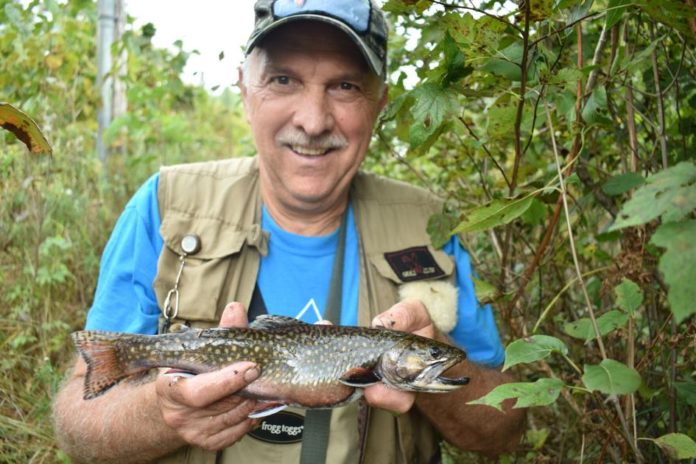KALKASKA — My first presentation was primo; a nice (not quite 10 inches) brook trout came out from under the bank and grabbed my offering. I shot the rod tip upward and jerked the fish out of the water and into my lap. Now that’s a start.
My second presentation was similar except there was a tag alder hanging over my head (so my hookset was a little less emphatic) and the fish was larger (about 12 inches) and it came unbuttoned before it got to me, flounced around in the grass, and before I could grab it, was back in the water. Sigh.
And that’s how it went for me; I eventually caught my fish, but not before Chuck Emmert had finished his limit and was catching and releasing more fish than I ever convinced to bite.
We were on a small stream, much of it surrounded by alder thickets, which I’ve been fishing with Emmert for about a decade now. When we first started fishing together Emmert was way better at brook trout fishing than I was. Ten years later he may be even more better.
But I guess that’s to be expected. Emmert — who recently retired to Tennessee and has come back to Michigan three times this year to fish for brook trout — has been at it, hard, for nearly 60 years.
A retired pastor, Emmert grew up brook trout fishing, fighting his way through the brush to drop worms into small streams, only to be rewarded with mostly small fish. And he’s totally happy with it.
“There are fewer and fewer guys who bust the brush,” said Emmert, 66. “Who wants to bust the brush when you can go out of Ludington or Manistee and catch a 30-pounder?
“But bigger does not mean better.”
Not that he’s opposed to catching nice fish; he had one that was 13 inches and another that went 12 ½ in his creel this day. But he’s happy with just nice keepers.
“I think the eight- and nine-inch fish are the best eating,” he said.
Emmert has honed his craft, snaking his rod through little openings in the brush — often on his knees — to drop a red worm just upstream from any deepish (i.e. more than two feet) hole, just upstream of a log or brush pile, and if there’s a brookie in there, odd are very good that he’ll catch them.
He does it with an eight-foot rod and six-pound test line, pulling enough line off the reel to pendulum his lure into any likely looking hidey hole, much the same way bass anglers flip a jig into a brush pile or cattail patch. But he keeps his left hand on the line and when a fish strikes, he gives it a strip set — like a fly fisherman does — and hauls it out of the water in one smooth move.
“I know some people use four-pound line, but I don’t feel the need to go any lighter,” he said. “If you get a real good fish, you could have a problem there.
“And I hardly ever use my reel, unless I’m fishing a beaver pond. Never.”
Unless he’s fly fishing, which he sometimes does, Emmert always uses red worms.
“There was time I was into Panther Martins (spinners) but I got the feeling I was killing too many fish with that treble hook. It was hard to prevent it.”
He experimented with grasshoppers and creek minnows, “but I think we’ll agree that worms are the most natural bait,” he said.
Emmert always set a goal of catching (but not necessarily keeping) 200 brook trout a year and almost always accomplished his goal.
“If I didn’t, it was because there something going on in our lives that cut my time short — things like kids being born,” he said.
Although he guesses he has fished some 35 brook trout streams in Michigan, he’s got it down to about a half dozen now. He always fished a couple of days every two weeks and rotated them so he didn’t overly pressure them.
“I used to explore but there’s no reason to go running all around in your own backyard,” he said. “If you spread them out and make the rounds you can come back every few weeks. Some people think they can fish the same stream all the time but if they fish two days and take 10 fish — and if they take someone with them 10 becomes 20 — they won’t hold up. Maybe if you fish a big stream, like the Manistee, you can fish that all the time, but I think rotating my streams is one of the best things I’ve ever done.”
It’s rare he doesn’t catch his limit — “if I’ve got a couple of hours I can get my five,” he says — but if he puts his mind to it and fishes hard, he says he thinks 20 to 25 is “a pretty good day.”
This year he thinks he’ll catch close to 100 making a trip back home in spring, summer and fall this year.
“I like cloudy days,” he said. “They’re too spooky otherwise, but I’ve had great days in every season, but seems like until it warms up spring is pretty slow. I didn’t make it up here for the opener this year — the first time in I don’t know how many years — and I don’t think I missed much.”
And he has found a mountain stream in Tennessee with brookies, and he has caught them, he said, but he always wants to come back to Michigan.
“It’s not the same,” he said.
Bob Gwizdz is a longtime outdoors writer and has also worked in public affairs for the Michigan Department of Natural Resources.
Credit: Source link































